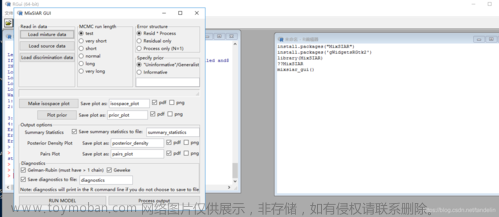前言
halo,包子们晚上好
今天给大家整一个基于pygame实现的可视化麻将
现在不是很多小伙伴都喜欢打麻将的嘛,逢年过节都会搓搓麻将的嘛,所以呀小编这边不就给大家安排上啦,源码啥的都可以直接给大家使用的哟
快跟你的小伙伴一起玩耍吧
相关文件
关注小编,私信小编领取哟!
当然别忘了一件三连哟~~
公众号:Python日志
开发工具
Python版本:3.7.8
相关模块:
pygame模块;
random模块;
GameTable模块;
Rule模块;
以及一些python自带的模块。
环境搭建
安装Python并添加到环境变量,pip安装需要的相关模块即可。
游戏规则
游戏中采取日麻无赤宝牌规则。共计 136 张麻将牌,其中包含 1-9 万/条/筒与东南西北中发白各 4 张(无花牌)。基本规则与国标麻将一致,区别主要在于:每轮对局中存在“宝牌”,胡牌时手牌中若持有宝牌则会有对应奖励;日麻胡牌需要满足特定条件,即为“役”,无役无法胡牌。
设计思路

效果展示
开始界面
玩家进入游戏后,首先会来到登录界面,登录界面中有我为这个游戏所设计的一个 Logo。此时玩家需要在 ID 栏中输入自己的 ID,并选择登录。登录后会来到欢迎界面,并提示玩家可以选择开始游戏
 文章来源:https://www.toymoban.com/news/detail-714007.html
文章来源:https://www.toymoban.com/news/detail-714007.html
游戏界面




 文章来源地址https://www.toymoban.com/news/detail-714007.html
文章来源地址https://www.toymoban.com/news/detail-714007.html
代码展示
基础操作
import copy
import pygame
import random
from GameTable import Gametable
from Rule import huJudge
from pygame.locals import *
from sys import exit
class Mahjong():
def __init__(self):
self.__clock = pygame.time.Clock()
self.screenSet() # 游戏画面设置
self.playerSet() # 玩家设置
self.sitSet() # 座次设置
self.gameStart() # 游戏开始
def screenSet(self):
pygame.init()
screen = pygame.display.set_mode((600, 400))
# screen 的本质上就是一个 Surface 对象,它是游戏的主窗口,
# 也就是整个游戏中尺寸最大的“纸”,任何其他的 Surface 对象都需要附着在这张最大的“纸”上
pygame.display.set_caption('Mahjong 源码领取QQ群:494958217')
def playerSet(self):
# self.__playername = input("请输入您的昵称:")
self.__playername = "飞翔大神天使" # 方便测试用
print("您好,{}!欢迎来到麻将世界!".format(self.__playername))
def sitSet(self):
self.__sit = random.randint(0, 3)
# self.__sit = 3
print("您这把{}起!".format("东南西北"[self.__sit]))
def prepare(self):
print("\n\n正在清理牌桌...")
self.__table = Gametable() # 清理牌桌
print("正在获取初始手牌...")
self.__hands = self.getfHands(self.__sit)
print(self.__hands)
def reset(self):
print("\n\n正在清理牌桌...")
self.__table = Gametable() # 清理牌桌
print("正在获取初始手牌...")
self.__hands = self.getfHands(self.__sit)
print(self.__hands)
def getfHands(self, sit):
hands = []
base = (sit-1) * 4 # 摸牌起始位置
# 东起 0,南起 4, 西起 8, 北起 12
for i in range(3): # 分3次摸2垛
hands.append(self.__table.getTiles()[i * 16 + base])
hands.append(self.__table.getTiles()[i * 16 + base + 1])
hands.append(self.__table.getTiles()[i * 16 + base + 2])
hands.append(self.__table.getTiles()[i * 16 + base + 3])
hands.append(self.__table.getTiles()[48 + base])
self.handsSort(hands)
return hands
def handsSort(self, hands):
hands.sort(key=Gametable.tiles.index)
return hands
def gameStart(self):
self.__game_num = 0 # 当前对局数
# self.__current_turn = 0 # 当前局数
self.__wind = "东" # 从东场开始
gamepara = self.__sit # 参数记录起始位置
while(self.__game_num < 8):
self.reset() # 准备下一局对局
print("sit:", self.__sit, "gamenum:", self.__game_num)
self.__sit = (gamepara - self.__game_num) % 4
print("欢迎来到{}{}场!".format(self.__wind, self.__game_num % 4 + 1))
print("您这把是{}家.".format("东南西北"[self.__sit]))
self.__game_num += 1
if self.__game_num % 4 == 0:
self.__wind = "南" # 进行4局后进入南场
if self.game() == 0: # 连庄则对局数不增加
self.__game_num -= 1
def game(self):
winner = -1
print("本局的宝牌指示牌为:", self.__table.getDoraPointer()[0])
self.__cardremain = 70 # 牌山余量
self.__cardgiver = 0 # 当前出牌人
self.__tilepointer = 52 # 牌山位置指针
self.__GangCount = 0 # 记录开杠次数
self.__Ganglist = [] # 杠牌
self.__Chowlist = [] # 吃牌
self.__PUNGlist = [] # 碰牌
self.__Reddora = [0, 0, 0] # 是否有赤宝牌
while(self.__cardremain > 0 and winner == -1):
brand = self.cardplay(self.__cardgiver)
if brand == "自摸":
return self.__sit
if self.__cardgiver % 4 != self.__sit:
self.can_gang(brand)
self.can_pung(brand)
if self.__cardgiver % 4 == (self.__sit + 3) % 4:
self.can_chow(brand)
winner = self.can_Hu(brand)
self.__cardgiver += 1
return winner
def cardplay(self, giver):
self.__cardremain -= 1
self.__tilepointer += 1
curCard = self.__table.getTiles()[self.__tilepointer - 1]
if giver % 4 != self.__sit:
print("{}家打出{}".format("东南西北"[giver % 4], curCard))
return self.__table.getTiles()[self.__tilepointer - 1] # 如果不是玩家直接摸切
# 如果是玩家本人
self.handsShow()
print("您摸到了:", curCard)
# 判断是否能开杠
self.can_gang(curCard)
# 判断是否自摸
if self.can_Hu(curCard, 1) != -1:
return "自摸"
self.__hands.append(curCard)
self.brand() # 舍牌
self.handsSort(self.__hands)
self.handsShow()
print()
def can_gang(self, card):
if self.__cardremain == 0 or self.__GangCount == 4:
return False
if card not in self.__hands:
return False
index = self.__hands.index(card)
if index > len(self.__hands) - 3:
return False
if self.__hands[index] == self.__hands[index + 1] == self.__hands[index + 2]:
ifGANG = input("杠?Y/N")
if ifGANG in "Yy1":
self.GANG(card)
return True
return False
def GANG(self, card):
self.__cardremain -= 1
self.__GangCount += 1
self.__cardgiver = self.__sit
for _ in range(3):
self.__hands.remove(card)
print("新的宝牌指示牌为:", self.__table.getDoraPointer()[self.__GangCount])
self.cardplay(self.__sit)
self.__Ganglist.append(card)
self.__hands.append(self.__table.getTiles()[-self.__GangCount])
def can_pung(self, card):
if card not in self.__hands:
return False
index = self.__hands.index(card)
if index > len(self.__hands) - 2:
return False
if self.__hands[index] == self.__hands[index + 1]:
ifPUNG = input("碰?Y/N")
if ifPUNG in "Yy1":
self.PUNG(card)
return True
return False
def PUNG(self, card):
self.__cardgiver = self.__sit
for _ in range(2):
self.__hands.remove(card)
self.__PUNGlist.append(card)
self.brand()
self.handsShow()
print()
def can_chow(self, card):
if card[0] in "fd":
return
lis = []
canchow = []
num = int(card[0])
for i in self.__hands:
if i[1] == card[1]:
lis.append(int(i[0]))
lis.sort()
# case 1: 1 2 (3)
if num > 2:
if num-1 in lis and num-2 in lis:
print(str(num - 2)+card[1] + str(num - 1)+card[1] + card, card, end=" ")
canchow.append(0)
# case 2: 1 (2) 3
if num > 1:
if num-1 in lis and num+1 in lis:
print(str(num - 1)+card[1] + card + str(num + 1)+card[1], card, end=" ")
canchow.append(1)
# case 3: (1) 2 3
if num < 8:
if num+1 in lis and num+2 in lis:
print(card + str(num + 1)+card[1] + str(num + 2)+card[1], card, end=" ")
canchow.append(2)
if len(canchow) == 1:
ifCHOW = input("吃?Y/N")
if ifCHOW in "Yy1":
self.CHOW(card, 0, canchow)
elif len(canchow) > 1:
ifCHOW = input("吃?1-{}/N".format(len(canchow)))
if ifCHOW in "123":
self.CHOW(card, eval(ifCHOW)-1, canchow)
return canchow
def CHOW(self, card, mode, lis):
self.__cardgiver = self.__sit
mode = lis[mode]
if mode == 0: # case 1: 1 2 (3)
for i in [str(int(card[0])-2)+card[1], str(int(card[0])-1)+card[1], card]:
if i != card:
self.__hands.remove(i)
self.__Chowlist.append(i)
elif mode == 1: # case 2: 1 (2) 3
for i in [str(int(card[0])-1)+card[1], card, str(int(card[0])+1)+card[1]]:
if i != card:
self.__hands.remove(i)
self.__Chowlist.append(i)
elif mode == 2: # case 3: (1) 2 3
for i in [card, str(int(card[0])+1)+card[1], str(int(card[0])+2)+card[1]]:
if i != card:
self.__hands.remove(i)
self.__Chowlist.append(i)
self.brand()
self.handsShow()
print()
def can_Hu(self, card, Self=0):
handstry = copy.deepcopy(self.__hands)
handstry.append(card)
if huJudge(self.handsSort(handstry), self.__Chowlist, self.__PUNGlist, self.__Ganglist):
if Self:
ifHU = input("自摸?Y/N")
else:
ifHU = input("胡?Y/N")
if ifHU in "Yy1":
self.__hands = handstry
self.HU(handstry)
return self.__sit
return -1
def HU(self, hands):
print("胡牌手牌:", end='')
self.handsShow()
print("恭喜{}家获得胜利!".format("东南西北"[self.__sit]))
def handsShow(self):
print(self.__hands, end=' ')
if self.__Ganglist != []:
print("已杠:", end='')
for i in self.__Ganglist:
print(i*4, end=' ')
if self.__PUNGlist != []:
print("已碰:", end='')
for i in self.__PUNGlist:
print(i*3, end=' ')
if self.__Chowlist != []:
print("已吃:", end='')
count = 0
for i in self.__Chowlist:
count += 1
print(i, end='')
if count % 3 == 0:
print(end=' ')
def brand(self):
brand = input("您要打出?") # 舍牌
if brand in self.__hands:
self.__hands.remove(brand)
elif brand in [str(i) for i in range(1, len(self.__hands)+1)]:
self.__hands.pop(eval(brand) - 1)
else:
self.__hands.pop()
胡牌算法
def huJudge(hands, Chowlis, Punglis, Ganglis):
count = len(Chowlis)/3 + len(Punglis) + len(Ganglis)
if count == 0:
if nanaJudge(hands) or kokushimusoJudge(hands):
return True
return tanyaoJudge(hands, count)
def nanaJudge(hands):
i = 0
temp = "0"
while i < 12:
if temp == hands[i]:
return False
if hands[i] != hands[i+1]:
return False
temp = hands[i]
i += 2
return True
def kokushimusoJudge(hands):
handscopy = copy.deepcopy(hands)
yaolist = ["1m", "9m", "1p", "9p", "1s", "9s", "d1", "d2", "d3",
"f1", "f2", "f3", "f4"]
for i in yaolist:
if i in handscopy:
handscopy.remove(i)
if len(handscopy) == 1 and handscopy[0] in yaolist:
return True
else:
return False
def tanyaoJudge(hands, count):
for i in hands:
if i[0] in "19fd":
return False
i = 0
while(i < len(hands)-1):
handscopy = copy.deepcopy(hands)
if hands[i] == hands[i + 1]:
handscopy.pop(i+1)
handscopy.pop(i)
if NormalJudge(handscopy, count):
return True
i += 1
return False
def NormalJudge(hands, count): # 如果是一般型
i = 0
while count < 4 and i < len(hands) - 2:
if hands[i+2] == hands[i+1] == hands[i]: # 刻子判断
count += 1
for _ in range(3):
hands.pop(i)
i -= 1
else: # 顺子判断
if str(int(hands[i][0])+1) + hands[i][1] in hands and
str(int(hands[i][0])+2) + hands[i][1] in hands:
count += 1
hands.remove(str(int(hands[i][0]) + 1) + hands[i][1])
hands.remove(str(int(hands[i][0]) + 2) + hands[i][1])
hands.pop(i)
i -= 1
else:
return False
i += 1
return True
到了这里,关于注意看,这个小编叫小帅,居然用Python做出了可视化麻将,而且还有详细教学 | 附源码的文章就介绍完了。如果您还想了解更多内容,请在右上角搜索TOY模板网以前的文章或继续浏览下面的相关文章,希望大家以后多多支持TOY模板网!












